fi
nimet breadcrumb-navigoinnissa


Die Pflanzengattung Ypsilandra gehört zur Familie der Germergewächse (Melanthiaceae). Die etwa sechs Arten sind in Asien verbreitet.
Ypsilandra-Arten wachsen als ausdauernde krautige Pflanzen. Diese Geophyten[1] bilden als Überdauerungsorgane unterirdische, kurze, verdickte, etwas fleischige Rhizome. Alle Pflanzenteile sind kahl.[2]
Die Laubblätter sind in einer grundständigen Rosette angeordnet. Die einfachen Blattspreiten sind linealisch bis lanzettlich, verkehrt-lanzettlich oder spatelförmig und im unteren Bereich allmählich stielartig verschmälert. Es liegt Parallelnervatur vor.[2]
In den Achseln der äußeren Laubblätter stehen mehr oder weniger lange, aufrechte, unverzweigte Blütenstandsschäfte, die einige bis viele schuppenförmige Blätter besitzen. Die traubigen Blütenstände enthalten 2 bis 30 meist hängende Blüten. Es sind meist keine Tragblätter vorhanden.[2]
Die zwittrigen Blüten sind radiärsymmetrisch und dreizählig. Die sechs gleichgestaltigen, haltbaren Blütenhüllblätter sind frei und stehen trichterförmig zusammen. Die Farben der Blütenhüllblätter reichen je nach Art von weiß bis gelb und von rosa- bis purpurfarben. An der Basis der Blütenhüllblätter befinden sich Nektarien. Es sind zwei Kreise mit je drei Staubblättern vorhanden; sie überragen meist die Blütenhüllblätter. Von den untereinander freien, sehr langen Staubfäden sind die inneren mit der Basis des Fruchtknotens, aber nie mit den Blütenhüllblättern verwachsen. Die basifixen Staubbeutel sind nierenförmig. Drei Fruchtblätter sind zu einem oberständigen, dreilappigen, dreikammerigen Fruchtknoten verwachsen. Jedes Fruchtknotenfach enthält viele Samenanlagen. Der je nach Art kurze bis lange Griffel endet in einer kopfigen bis dreispaltigen Narbe.[2]
Die aufsteigenden Kapselfrüchte sind lokulizid, dreikantig, im oberen Bereich dreilappig und enthalten viele Samen. Die schmal spindelförmigen Samen sind an beiden Enden geschwänzt.[2]
Die Chromosomenzahlen liegen mit 2n = 34 nur für Ypsilandra thibetica vor.[2]
Die Gattung Ypsilandra wurde 1888 durch Adrien René Franchet in Nouvelles archives du muséum d'histoire naturelle, Série 2, 10, S. 93 aufgestellt. Typusart ist Ypsilandra thibetica Franch.[3] Der Gattungsname Ypsilandra leitet sich von den griechischen Wörtern ypsilo für Y-förmig und andra für Staubblatt ab; dies bezieht sich darauf, dass bei einigen Arten die Staubbeutel wie ein Peace-Zeichen dreilappig gespalten sind.
Die Gattung Ypsilandra in der Tribus Heloniadeae innerhalb der Familie Melanthiaceae. Die Tribus Heloniadeae hatte früher auch den Rang einer Familie Heloniadaceae oder wurde in die Familie der Liliaceae eingeordnet.[4] Die Tribus Heloniadeae enthält drei Gattungen, die alle Elemente der Arkto-Tertiären Geoflora sind. Helonias kommt im östlichen Nordamerika und Ypsilandra (Vietnam über westliches China bis Himalaya) sowie Heloniopsis (Sachalin, Korea, Taiwan und Japan) kommen im östlichen Asien vor (N. Tanaka 1997).[4][2]
Die Gattung Ypsilandra kommt in Bhutan (eine Art), Nepal (eine Art), Myanmar (zwei Arten), Vietnam (eine Art) Taiwan (eine Art) und der Volksrepublik China (alle sechs Arten, zwei davon nur dort) vor.[2]
Es gibt etwa sechs Ypsilandra-Arten:[1][2]
Ypsilandra thibetica (蕊花 Ya rui hua) wird als blutstillende Droge in der traditionellen chinesischen Medizin eingesetzt, besonders in den Provinzen Sichuan sowie Yunnan.[5][6]
Die Pflanzengattung Ypsilandra gehört zur Familie der Germergewächse (Melanthiaceae). Die etwa sechs Arten sind in Asien verbreitet.
Ypsilandra is a genus of at least six herbaceous plant species, first described as a genus in 1888. This genus is a member of the Melanthiaceae[2] and is native to East Asia (China, the Himalayas, Myanmar, Thailand).[3][4]
Ypsilandra species are perennial plants that grow from thick rhizomes. They are associated with sloping, forested habitats. They are very infrequently cultivated in the West. Their leaves are generally long and thin, growing in a rosette from the base of the plant. Ypsilandra species produce flowers on a long scape arising from the intersection of the leaves and the stem. The inflorescences consist of a cluster of nodding, radially-symmetrical tube-shaped flowers with six tepals. The stamens protrude beyond the tepals. Depending on the species, the tepals may be white, pink, purple, or yellow.[5]
Ypsilandra thibetica is used in traditional Chinese medicine, especially in Sichuan and Yunnan provinces, as a haemostatic.[6]
Ypsilandra is a genus of at least six herbaceous plant species, first described as a genus in 1888. This genus is a member of the Melanthiaceae and is native to East Asia (China, the Himalayas, Myanmar, Thailand).
Ypsilandra species are perennial plants that grow from thick rhizomes. They are associated with sloping, forested habitats. They are very infrequently cultivated in the West. Their leaves are generally long and thin, growing in a rosette from the base of the plant. Ypsilandra species produce flowers on a long scape arising from the intersection of the leaves and the stem. The inflorescences consist of a cluster of nodding, radially-symmetrical tube-shaped flowers with six tepals. The stamens protrude beyond the tepals. Depending on the species, the tepals may be white, pink, purple, or yellow.
Species Ypsilandra alpina F.T.Wang & Tang - Tibet, Yunnan, N Myanmar Ypsilandra cavaleriei H.Lév. & Vaniot - Guangdong, Guangxi, Guizhou, Hunan Ypsilandra jinpingensis W.H.Chen, Y.M.Shui & ZhiY.Yu - Yunnan, N Vietnam Ypsilandra kansuensis R.N.Zhao & Z.X.Peng - Gansu Ypsilandra thibetica Franch. - Sichuan, Hunan, Guangxi, Taiwan Ypsilandra yunnanensis W.W.Sm. & Jeffrey - Nepal, Yunnan, Bhutan, Assam, MyanmarYpsilandra thibetica is used in traditional Chinese medicine, especially in Sichuan and Yunnan provinces, as a haemostatic.
Ypsilandra es un género de plantas con flores perteneciente a la familia Melanthiaceae. Comprende seis especies.es originario de Nepal hasta China.[1]
Ypsilandra es un género de plantas con flores perteneciente a la familia Melanthiaceae. Comprende seis especies.es originario de Nepal hasta China.
Ypsilandra Franch. – rodzaj ziemnopączkowych roślin zielnych z rodziny melantkowatych, obejmujący 6 gatunków, występujących w Azji, na obszarze od Nepalu do Chin[3].
Ypsilandra Franch. – rodzaj ziemnopączkowych roślin zielnych z rodziny melantkowatych, obejmujący 6 gatunków, występujących w Azji, na obszarze od Nepalu do Chin.
Ypsilandra é um género botânico pertencente à família Melanthiaceae.[1]
Ypsilandra é um género botânico pertencente à família Melanthiaceae.
丫蕊花属(学名:Ypsilandra)是百合科下的一个属,为多年生草本植物。该属共有5种,分布于缅甸及中国西南部和南部。[1]